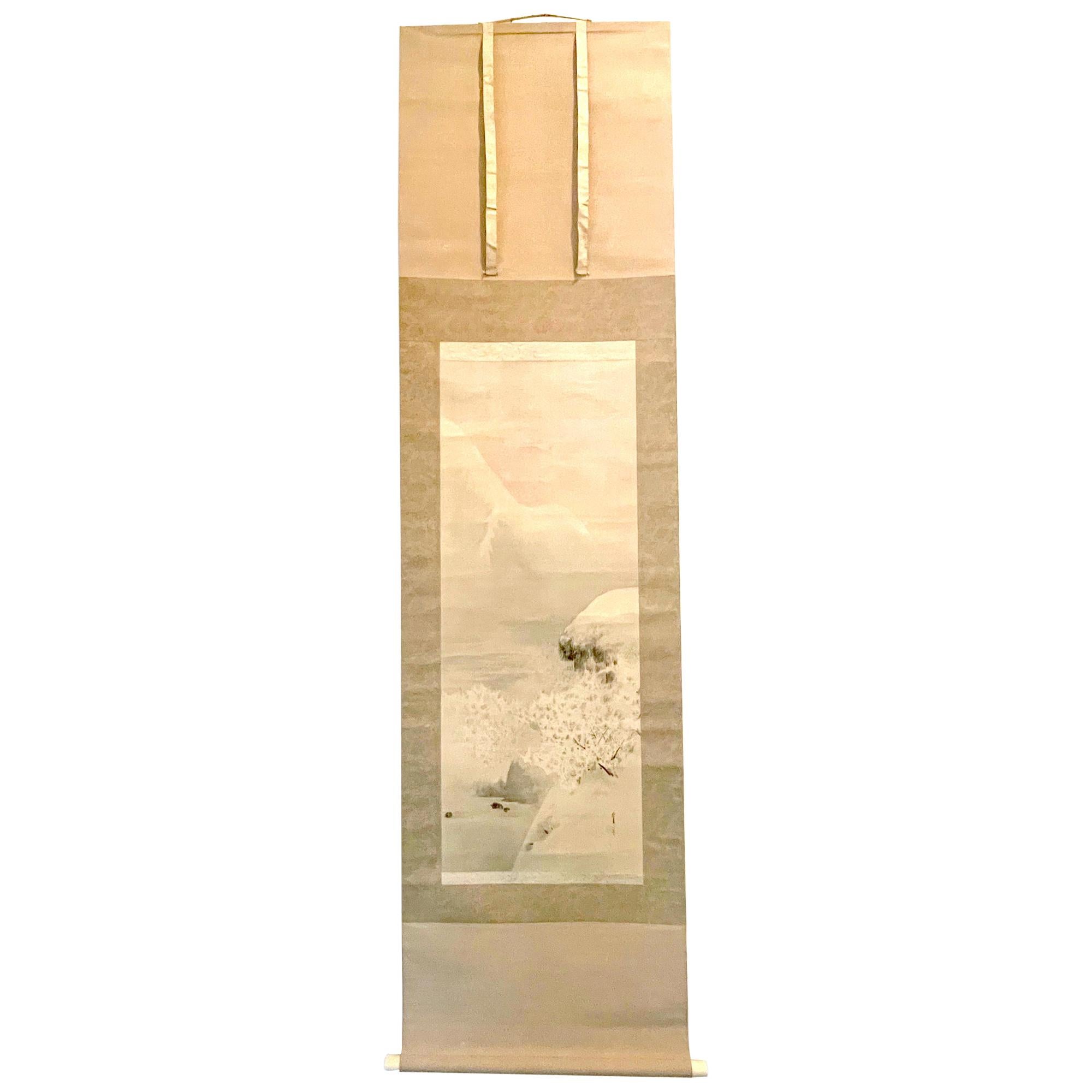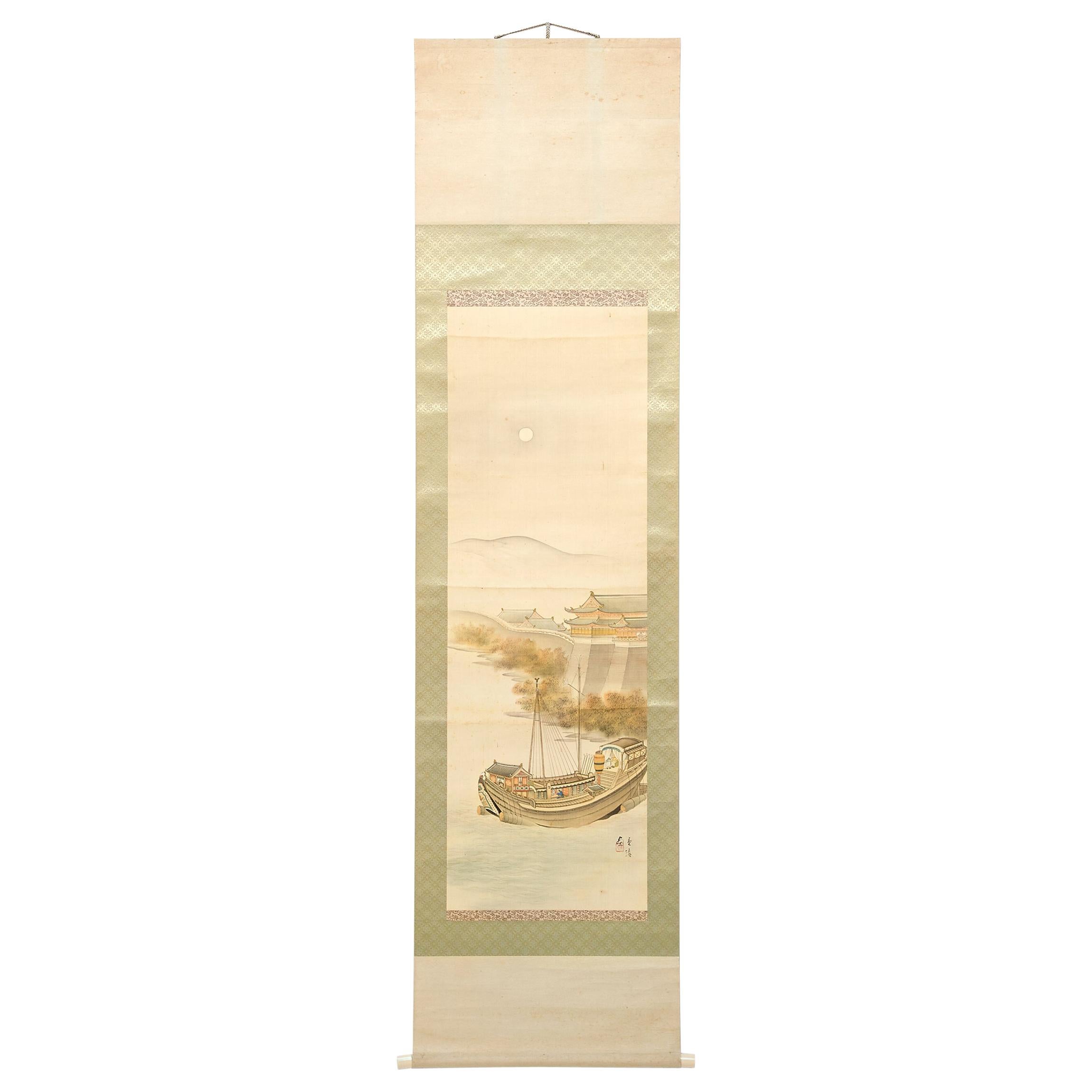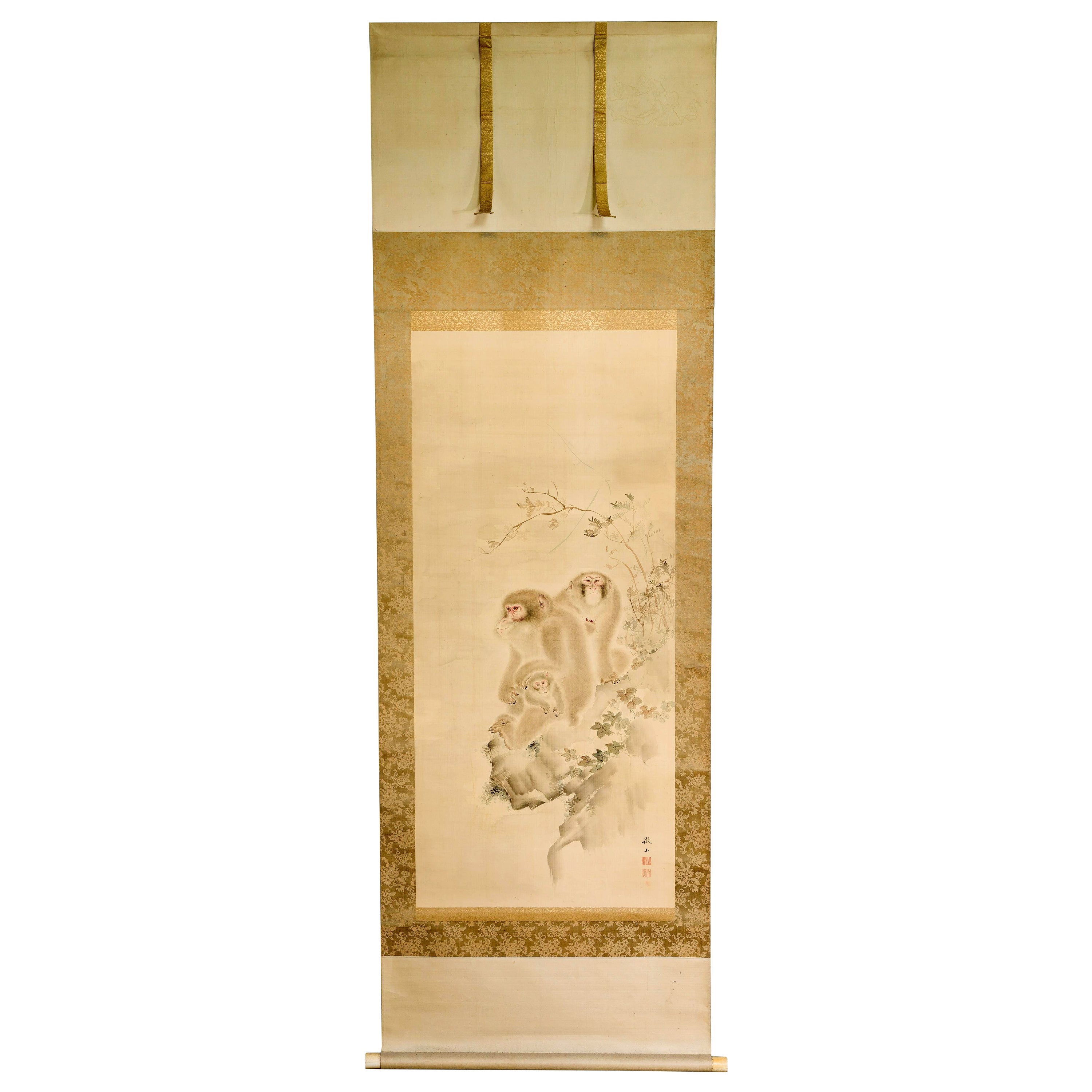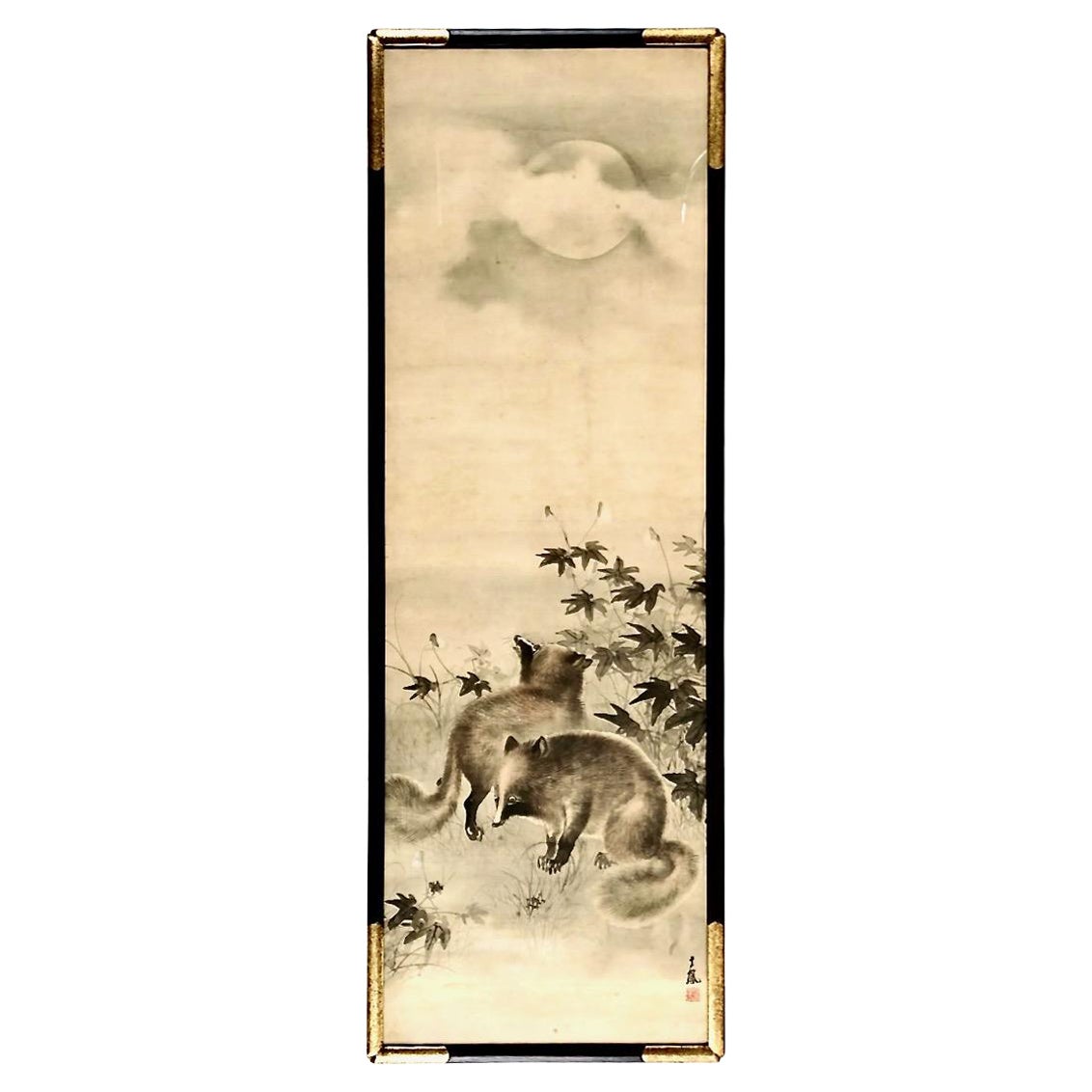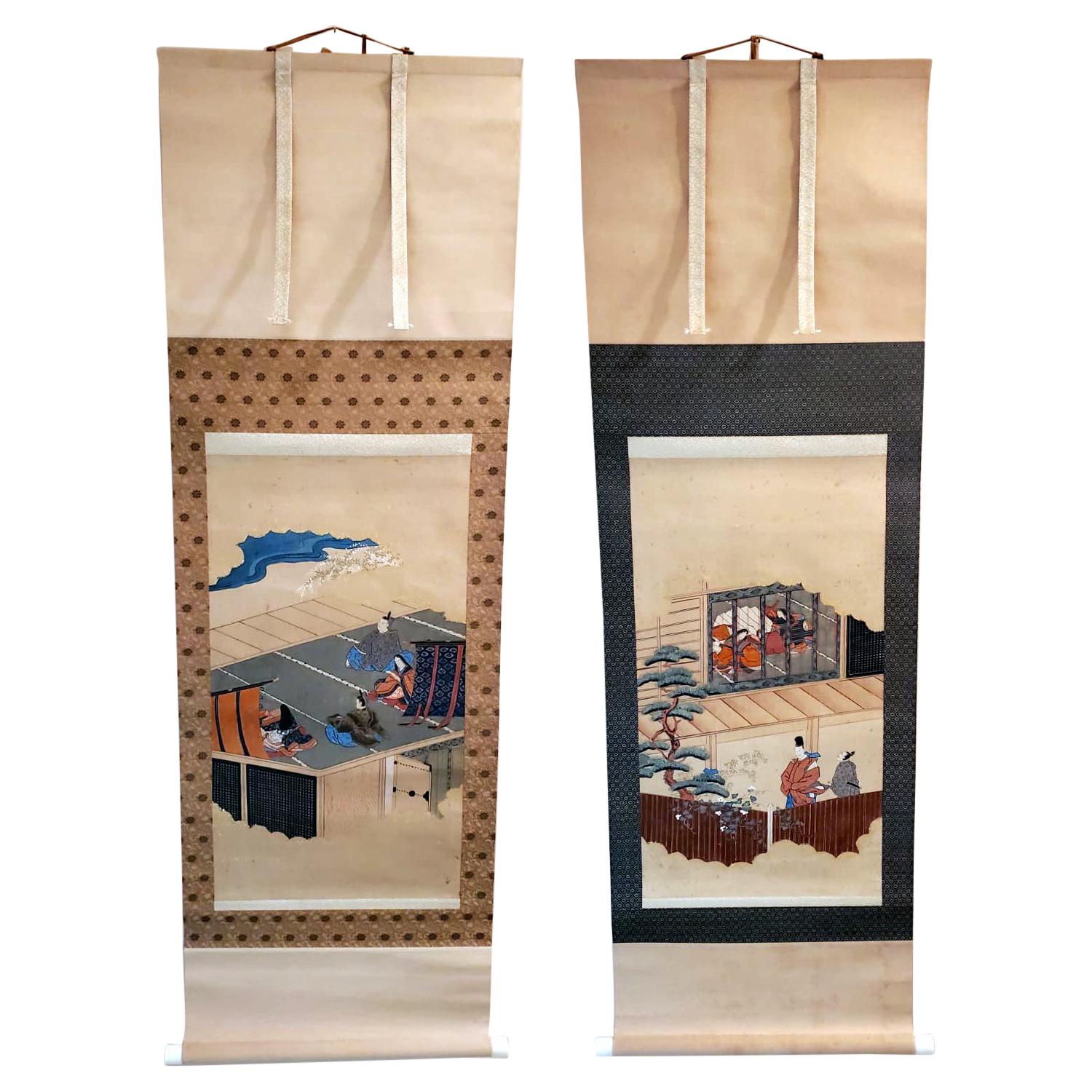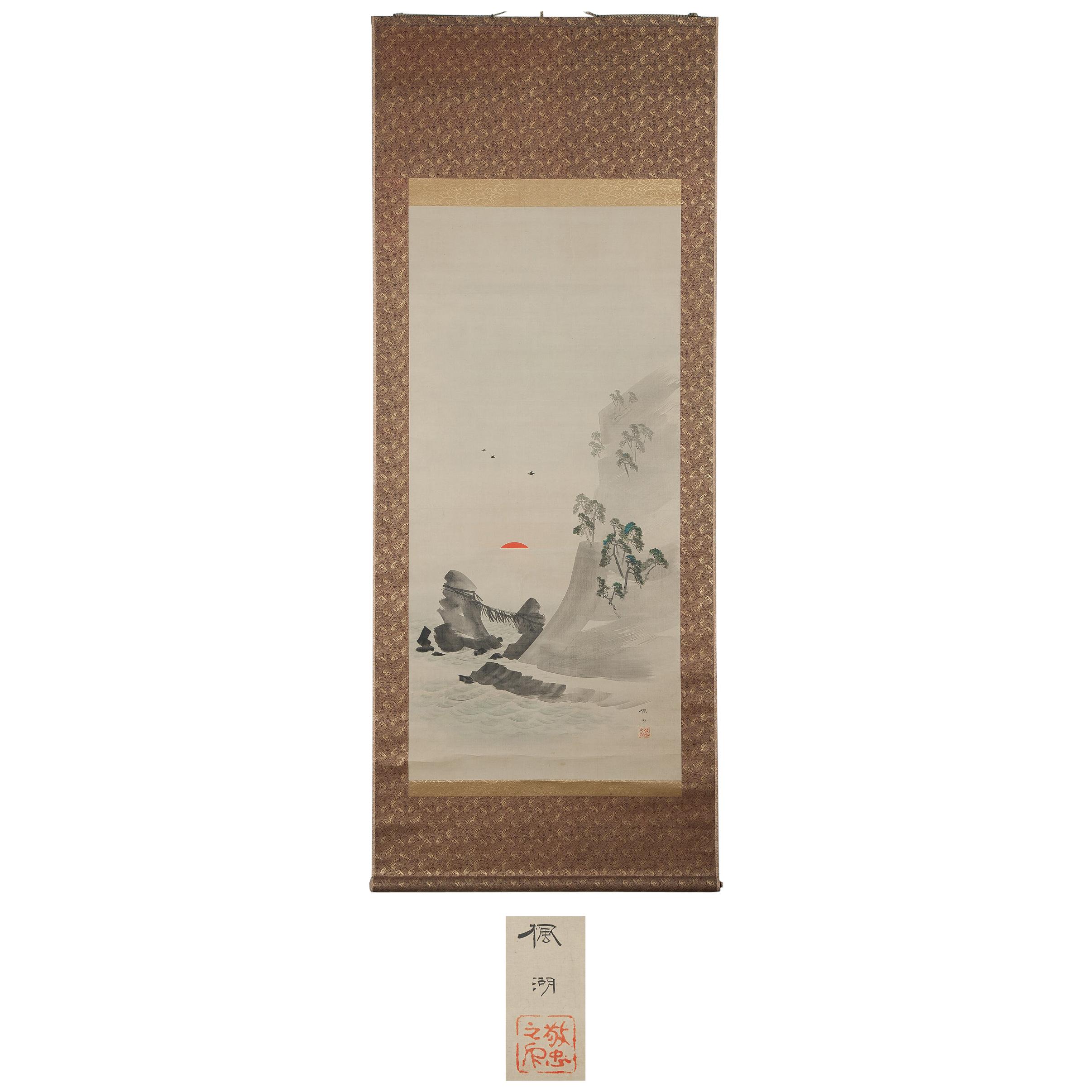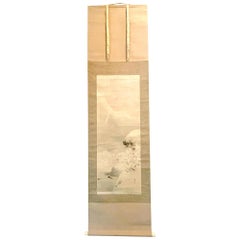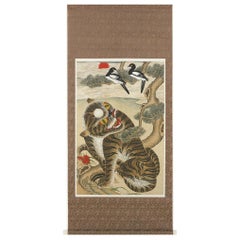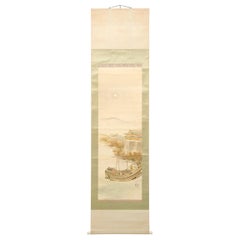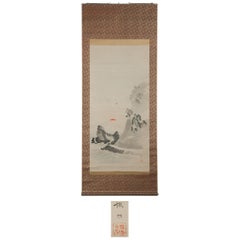Items Similar to Rare Triptych Scroll Paintings by Watanabe Seitei Meiji Period
Want more images or videos?
Request additional images or videos from the seller
1 of 21
Rare Triptych Scroll Paintings by Watanabe Seitei Meiji Period
About the Item
A set of three paintings of ink and watercolor on silk mounted within brocade borders as scrolls by Watanabe Seitei (1851-1918). This is a very rare and well preserved triptych by the artist, signed and dated to the year of 1902, Meiji 35th year. They were likely created for a specific client with a hanging location in mind as each piece was marked left, middle or right as a prearrangement. The middle scroll depicts a samurai in his full armor holding a staff on horseback marching with his two foot soldiers in a mountainous landscape. The left and right scrolls were extensions of the landscape done in his classic Nihonga (New Japanese style) influenced not only by Chinese classic ink wash painting but also a western dimensional, minimalistic and almost impressionist style. Although the landscape is not a physical continuation of the middle part, it conveys a sense of time and place where the traveling trespassed. The left is clearly a summer day with swallows flying in the breeze above a pond dotted with lotus. The mist rises to blur the visage of the hills afar. The right side is a nightly scene under a crescent moon. At the edge of the water, a thatched pavilion perched lonely among the trees Again the ink wash created a dreamy misty effect, suggesting perhaps the unknown nature of the journey. All three scrolls were signed and sealed "Seitei" with the middle one dated to 1902 Spring Summer in Kanji. It appears that the triptych has always been kept as a set in the persimmon wood box with a kiri wood interior holder custom-made for them. Under the cover of the lid, there is a red seal as well as a paper label with a collector's seal on it. However, it is hard to decipher the archaic form completely but it appears to be "Nine Layer Gao Residence collection". When hanging, the measurement is 22' x 82". The measurement posted is the size of the storage wood box.
Watanabe Seitei, also known as Watanabe Shotei (1851–1918), was born in late Edo period. He was one of the earliest Japanese artists who visited and became well-known in the West. In 1878, he travelled to France and attended International Exhibition in Paris and stayed for three years. Due to his exposure to the art in the west, his work, known as Nihonga (Japanese-style), blended a sense of Western realism with Japanese approach to aesthetics by using ink wash and delicate colors. He is also well known for the designs he created for cloisonné artist Namikawa Sosuke (1847–1910), whose work became quite famous and collectible in the west at the beginning of the 20th century. His artistic style had an important and long impact on the later Nihonga painters.
- Dimensions:Height: 4.75 in (12.07 cm)Width: 26.75 in (67.95 cm)Depth: 9 in (22.86 cm)
- Style:Japonisme (Of the Period)
- Materials and Techniques:
- Place of Origin:
- Period:1900-1909
- Date of Manufacture:1902
- Condition:Wear consistent with age and use. The scrolls are in fine antique condition with expected creases on silk. The middle scroll shows minor foxing in area. The storage box shows some wear.
- Seller Location:Atlanta, GA
- Reference Number:1stDibs: LU945023400232
About the Seller
4.9
Platinum Seller
Premium sellers with a 4.7+ rating and 24-hour response times
Established in 2006
1stDibs seller since 2010
542 sales on 1stDibs
Typical response time: <1 hour
- ShippingRetrieving quote...Shipping from: Atlanta, GA
- Return Policy
Authenticity Guarantee
In the unlikely event there’s an issue with an item’s authenticity, contact us within 1 year for a full refund. DetailsMoney-Back Guarantee
If your item is not as described, is damaged in transit, or does not arrive, contact us within 7 days for a full refund. Details24-Hour Cancellation
You have a 24-hour grace period in which to reconsider your purchase, with no questions asked.Vetted Professional Sellers
Our world-class sellers must adhere to strict standards for service and quality, maintaining the integrity of our listings.Price-Match Guarantee
If you find that a seller listed the same item for a lower price elsewhere, we’ll match it.Trusted Global Delivery
Our best-in-class carrier network provides specialized shipping options worldwide, including custom delivery.More From This Seller
View AllJapanese Ink and Wash Scroll Painting by Watanabe Seitei
Located in Atlanta, GA
Watanabe Seitei, also known as Watanabe Shotei (1851–1918), was born in late Edo period. He was one of the earliest Japanese artists who visited and be...
Category
Antique Early 1900s Japanese Japonisme Paintings and Screens
Materials
Brocade, Silk, Paper
Japanese Silk Scroll Painting of Moneys Edo Period Mori Tetsuzan
Located in Atlanta, GA
A Japanese mounted vertical hanging scroll painting by Mori Tetsuzan (Japanese, 1775-1841) circa 19th century Edo period. The watercolor and ink on silk ...
Category
Antique 19th Century Japanese Japonisme Paintings and Screens
Materials
Silk, Paper
Two Antique Japanese Hanging Scroll Paintings
Located in Atlanta, GA
Two Japanese scroll painting depicts scenes from the Tale of Genji (Genji-E), from Edo period. These painting were purchased from Odewara Shoten in the...
Category
Antique Early 19th Century Japanese Japonisme Paintings and Screens
Materials
Brocade, Paper
$4,800 / set
Korean Jakhodo Minhwa Folk Scroll Painting
Located in Atlanta, GA
A Korean Folk Art painting mounted as a hanging scroll. The watercolor on paper was likely dated from 1930s-1940s. The work depicts a "Jakhodo" theme (...
Category
Vintage 1930s Korean Folk Art Paintings and Screens
Materials
Paper
Pair of Japanese Ink Hanging Scrolls Kano Tanyu
By Kano Tan'yu 1
Located in Atlanta, GA
A fine matching pair of hanging scrolls ink on paper mounted in green brocade borders circa Edo period (17-18th century). The Kano school painting depicts wild geese in the reeds by the margin of water, a popular subject borrowed from the Chinese tradition. Both painting were signed as Tanyu with a red seal of Morinobu, his birth name. The storage box is also present and was inscribed with the title Painting of Geese and Reeds and Kano Tanyu...
Category
Antique Late 17th Century Japanese Japonisme Paintings and Screens
Materials
Wood, Paper
$6,000 / set
Antique Japanese Hanging Scroll Attributed to Iwasa Matabei
Located in Atlanta, GA
An antique ink and color on paper hanging scroll (kakejiku) with brocade border. It appears to be a fragment of a larger hand scroll depicting a procession of a lord with his entoura...
Category
Antique Early 17th Century Japanese Japonisme Paintings and Screens
Materials
Silk, Paper
You May Also Like
Japanese Meiji Riverside Scroll Painting, c. 1900
Located in Chicago, IL
Although western painting was initially embraced during Japan’s Meiji period (1868-1912), artists brought on a revival of traditional painting styles as they sought to create a modern Japanese style with roots in the past. This exquisite hanging scroll demonstrates the preference for soft layering of gray tones with judicious use of color. The landscape is rendered in soft ink washes that subtly distinguish between water, mountain, and sky. The scroll painting...
Category
Early 20th Century Japanese Meiji Paintings and Screens
Materials
Paper
Japan Scroll Painting, Meiji Period
Located in Pasadena, CA
This is a wonderful example of a Meiji Period screen painting of Japanese Tanuki or racoon dogs in a landscape. The Tanuki is considered to be a mythical creature Japanese culture. T...
Category
Antique Late 19th Century Japanese Meiji Paintings and Screens
Materials
Fabric, Paint
$1,850 Sale Price
24% Off
Lovely Meiji Period Scroll Paintings Japan Meiji Artist Fuko Matsumoto
Located in Amsterdam, Noord Holland
Fuko Matsumoto, order of the rising sun,
Size: Axis, vertical 212.5 cm next to 84.7 cm
Painting, vertical 140.8 cm horizontal 66.7cm ? Differs slightly in size.
Condition: The state is good, but, wrinkle-thin stain
Biography Fuko Matsumoto 1840-1923
Japan painter. Ibaraki prefecture production. Imperial Art Academy member.
Fuko was born as the 3rd son of Matsumoto Soan in Kawachi County of Hitachi Province (Now Inashiki City of Ibaraki Prefecture) on September 14 of the 11th year of the Tenpo era.
His real given name was Toshiro.
In 1853, when Fuko was 14 years old, he went to Edo and studied painting under Oki Ichiga, who was an official painter of Tottori Domain.
Ichiga was a painter who studied the Kano, the Rinpa and the Nanpin styles, and was good at expressing flowers & birds in deep colors.
Later, Fuko studied painting under Satake Eikai, who was best pupil of Tani Buncho...
Category
Antique 19th Century Japanese Meiji Paintings and Screens
Materials
Fabric
$1,088 Sale Price
25% Off
17th Century Korean Grapevine and Squirrel Scroll Painting, Mid Joseon Period
Located in Kyoto, JP
Anonymous. Korean, 17th century. Joseon period.
Hanging scroll. Ink on paper.
Seal: Shinso
Dimensions:
Scroll: H. 200 cm x W. 31 cm (79” x 12”)
Image: H. 122 cm x W. 29.5 cm (48” x 11.5”)
The grapevine came to China and then Korea from western Asia via the silk road trade routes. By the mid-Joseon period, it was one of the most popular subjects for Korean literati painters. Grapevines were painted as a singular subject or, less commonly, in combination with squirrels, which are associated with children due to their playful nature. Together, grapevines and squirrels embody wishes for abundant offspring and wealth.
For the Korean literati artist the twisting vines, curling tendrils and round, plump grapes provided ample opportunity for expressive "brush play”. In this painting the artist has abstracted the scene and is seemingly unconcerned with discontinuities and proportion. Vines spring up from nowhere, grapes hang in random clusters and the squirrel’s head appears as if twisted backwards. For the vines and leaves we can feel a sense of speed in the brushstrokes, imparting a dynamic feel which is at once intense and animated. This contrasts dramatically with the countless tiny strokes of ink which realistically capture the texture of the squirrel’s fur...
Category
Antique 17th Century Korean Other Paintings and Screens
Materials
Paper
Immortals Nihonga Scene Meiji/Taisho Period Scroll Japan Artist Meiji Period
Located in Amsterdam, Noord Holland
Some errors will occur in the dimensions. Please understand.
Status I don't know the details of the author, but this item is hand-drawn rather than printed. Measures: Axis vertical ...
Category
20th Century Japanese Meiji Paintings and Screens
Materials
Silk
$789 Sale Price
20% Off
Immortals Nihonga Scene Meiji/Taisho Period Scroll Japan Artist Meiji Period
Located in Amsterdam, Noord Holland
Axis: Vertical 186 cm, Horizontal 47 cm
Inside: Vertical 107 cm, Horizontal 35 cm *Some errors will occur in the dimensions. Please understand.
Status I don't know the details of t...
Category
Antique 19th Century Japanese Meiji Paintings and Screens
Materials
Silk
$789 Sale Price
20% Off
